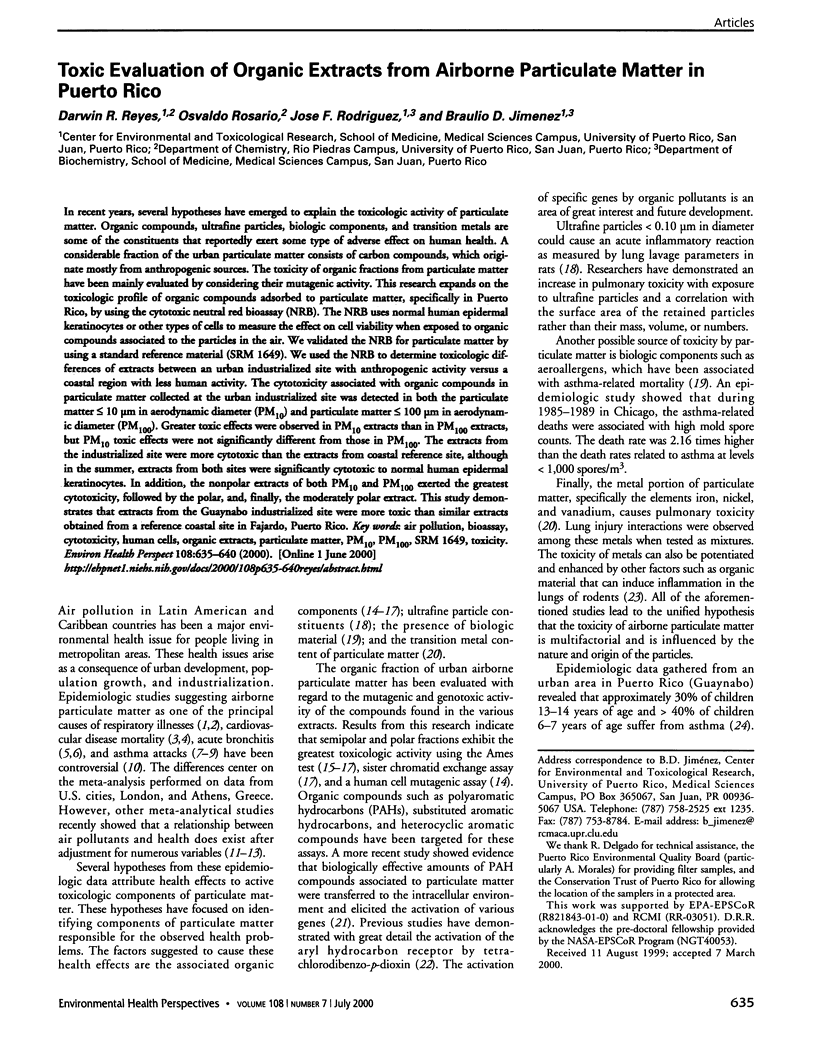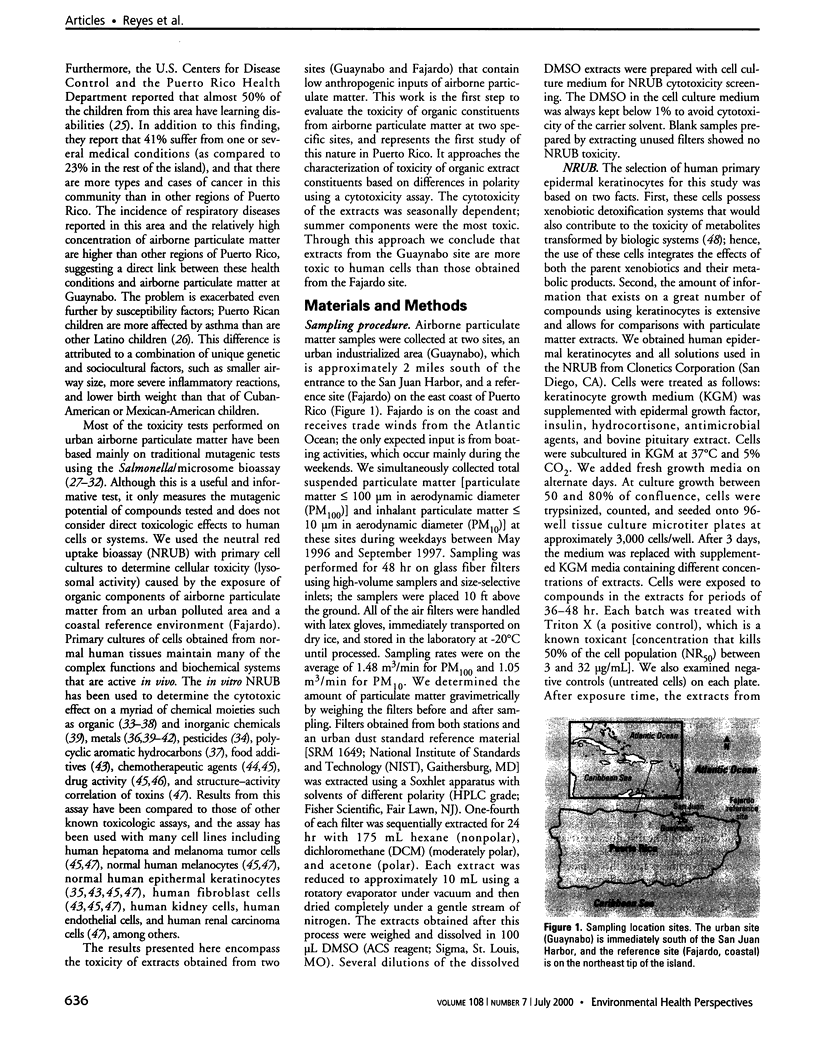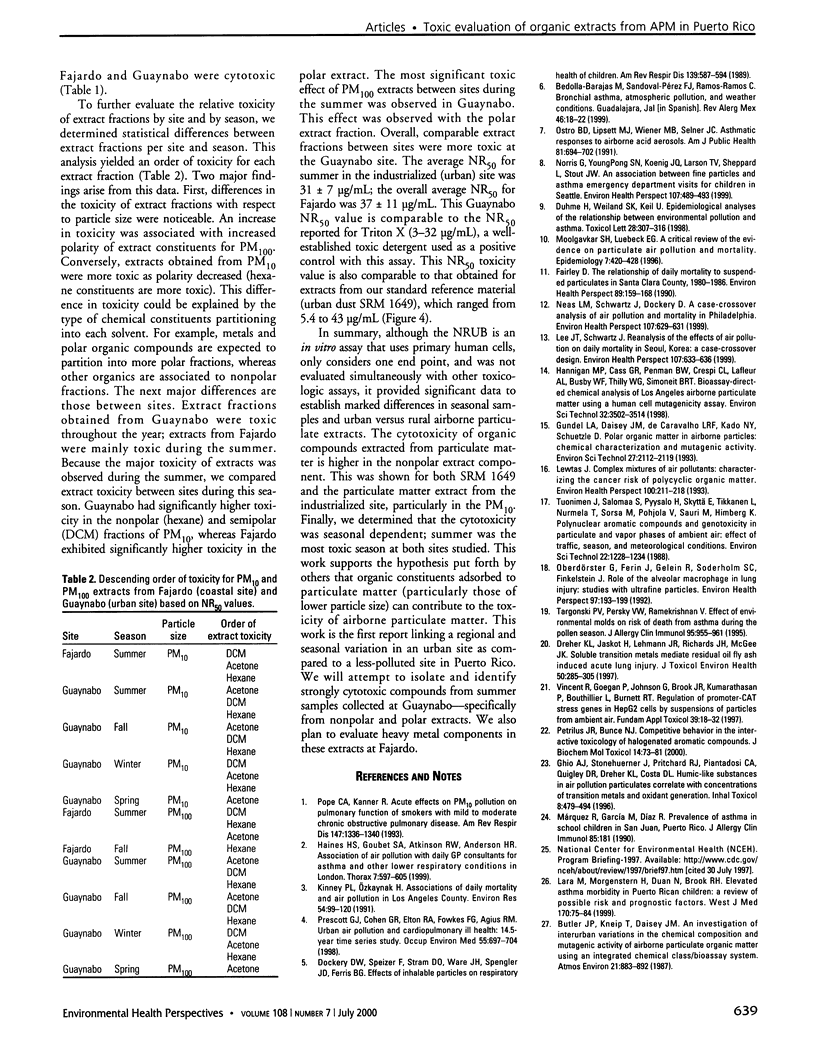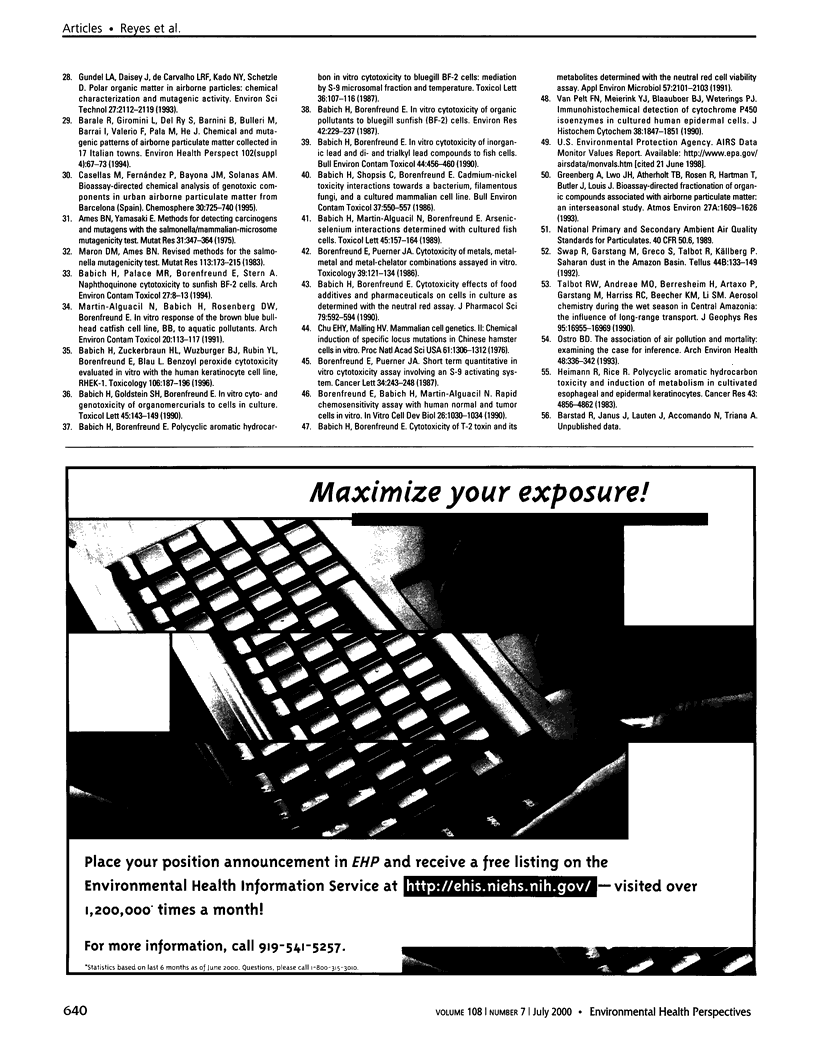Abstract
In recent years, several hypotheses have emerged to explain the toxicologic activity of particulate matter. Organic compounds, ultrafine particles, biologic components, and transition metals are some of the constituents that reportedly exert some type of adverse effect on human health. A considerable fraction of the urban particulate matter consists of carbon compounds, which originate mostly from anthropogenic sources. The toxicity of organic fractions from particulate matter have been mainly evaluated by considering their mutagenic activity. This research expands on the toxicologic profile of organic compounds adsorbed to particulate matter, specifically in Puerto Rico, by using the cytotoxic neutral red bioassay (NRB). The NRB uses normal human epidermal keratinocytes or other types of cells to measure the effect on cell viability when exposed to organic compounds associated to the particles in the air. We validated the NRB for particulate matter by using a standard reference material (SRM 1649). We used the NRB to determine toxicologic differences of extracts between an urban industrialized site with anthropogenic activity versus a coastal region with less human activity. The cytotoxicity associated with organic compounds in particulate matter collected at the urban industrialized site was detected in both the particulate matter (3/4) 10 microm in aerodynamic diameter (PM(10)) and particulate matter (3/4) 100 microm in aerodynamic diameter (PM(100)). Greater toxic effects were observed in PM(10) extracts than in PM(100) extracts, but PM(10) toxic effects were not significantly different from those in PM(100). The extracts from the industrialized site were more cytotoxic than the extracts from coastal reference site, although in the summer, extracts from both sites were significantly cytotoxic to normal human epidermal keratinocytes. In addition, the nonpolar extracts of both PM(10) and PM(100) exerted the greatest cytotoxicity, followed by the polar, and, finally, the moderately polar extract. This study demonstrates that extracts from the Guaynabo industrialized site were more toxic than similar extracts obtained from a reference coastal site in Fajardo, Puerto Rico.
Full text
PDF





Images in this article
Selected References
These references are in PubMed. This may not be the complete list of references from this article.
- Ames B. N., Mccann J., Yamasaki E. Methods for detecting carcinogens and mutagens with the Salmonella/mammalian-microsome mutagenicity test. Mutat Res. 1975 Dec;31(6):347–364. doi: 10.1016/0165-1161(75)90046-1. [DOI] [PubMed] [Google Scholar]
- Babich H., Borenfreund E. Cytotoxic effects of food additives and pharmaceuticals on cells in culture as determined with the neutral red assay. J Pharm Sci. 1990 Jul;79(7):592–594. doi: 10.1002/jps.2600790709. [DOI] [PubMed] [Google Scholar]
- Babich H., Borenfreund E. Cytotoxicity of T-2 toxin and its metabolites determined with the neutral red cell viability assay. Appl Environ Microbiol. 1991 Jul;57(7):2101–2103. doi: 10.1128/aem.57.7.2101-2103.1991. [DOI] [PMC free article] [PubMed] [Google Scholar]
- Babich H., Borenfreund E. In vitro cytotoxicities of inorganic lead and di- and trialkyl lead compounds to fish cells. Bull Environ Contam Toxicol. 1990 Mar;44(3):456–460. doi: 10.1007/BF01701229. [DOI] [PubMed] [Google Scholar]
- Babich H., Borenfreund E. In vitro cytotoxicity of organic pollutants to bluegill sunfish (BF-2) cells. Environ Res. 1987 Feb;42(1):229–237. doi: 10.1016/s0013-9351(87)80024-5. [DOI] [PubMed] [Google Scholar]
- Babich H., Borenfreund E. Polycyclic aromatic hydrocarbon in vitro cytotoxicity to bluegill BF-2 cells: mediation by S-9 microsomal fraction and temperature. Toxicol Lett. 1987 Apr;36(2):107–116. doi: 10.1016/0378-4274(87)90174-3. [DOI] [PubMed] [Google Scholar]
- Babich H., Goldstein S. H., Borenfreund E. In vitro cyto- and genotoxicity of organomercurials to cells in culture. Toxicol Lett. 1990 Feb;50(2-3):143–149. doi: 10.1016/0378-4274(90)90004-6. [DOI] [PubMed] [Google Scholar]
- Babich H., Martin-Alguacil N., Borenfreund E. Arsenic-selenium interactions determined with cultured fish cells. Toxicol Lett. 1989 Feb;45(2-3):157–164. doi: 10.1016/0378-4274(89)90005-2. [DOI] [PubMed] [Google Scholar]
- Babich H., Palace M. R., Borenfreund E., Stern A. Naphthoquinone cytotoxicity to bluegill sunfish BF-2 cells. Arch Environ Contam Toxicol. 1994 Jul;27(1):8–13. doi: 10.1007/BF00203880. [DOI] [PubMed] [Google Scholar]
- Babich H., Shopsis C., Borenfreund E. Cadmium-nickel toxicity interactions towards a bacterium, filamentous fungi, and a cultured mammalian cell line. Bull Environ Contam Toxicol. 1986 Oct;37(4):550–557. doi: 10.1007/BF01607803. [DOI] [PubMed] [Google Scholar]
- Barale R., Giromini L., Del Ry S., Barnini B., Bulleri M., Barrai I., Valerio F., Pala M., He J. Chemical and mutagenic patterns of airborne particulate matter collected in 17 Italian towns. Environ Health Perspect. 1994 Oct;102 (Suppl 4):67–73. doi: 10.1289/ehp.94102s467. [DOI] [PMC free article] [PubMed] [Google Scholar]
- Bedolla Barajas M., Sandoval Perez F. J., Ramos Ramos C. Asma bronquial, contaminación atmosférica y condiciones climatológicas. Guadalajara, Jal. Rev Alerg Mex. 1999 Jan-Feb;46(1):18–22. [PubMed] [Google Scholar]
- Borenfreund E., Babich H., Martin-Alguacil N. Rapid chemosensitivity assay with human normal and tumor cells in vitro. In Vitro Cell Dev Biol. 1990 Nov;26(11):1030–1034. doi: 10.1007/BF02624436. [DOI] [PubMed] [Google Scholar]
- Borenfreund E., Puerner J. A. Cytotoxicity of metals, metal-metal and metal-chelator combinations assayed in vitro. Toxicology. 1986 May;39(2):121–134. doi: 10.1016/0300-483x(86)90130-7. [DOI] [PubMed] [Google Scholar]
- Borenfreund E., Puerner J. A. Short-term quantitative in vitro cytotoxicity assay involving an S-9 activating system. Cancer Lett. 1987 Mar;34(3):243–248. doi: 10.1016/0304-3835(87)90173-x. [DOI] [PubMed] [Google Scholar]
- Casellas M., Fernandez P., Bayona J. M., Solanas A. M. Bioassay-directed chemical analysis of genotoxic components in urban airborne particulate matter from Barcelona (Spain). Chemosphere. 1995 Feb;30(4):725–740. doi: 10.1016/0045-6535(94)00438-z. [DOI] [PubMed] [Google Scholar]
- Chu E. H., Malling H. V. Mammalian cell genetics. II. Chemical induction of specific locus mutations in Chinese hamster cells in vitro. Proc Natl Acad Sci U S A. 1968 Dec;61(4):1306–1312. doi: 10.1073/pnas.61.4.1306. [DOI] [PMC free article] [PubMed] [Google Scholar]
- Dockery D. W., Speizer F. E., Stram D. O., Ware J. H., Spengler J. D., Ferris B. G., Jr Effects of inhalable particles on respiratory health of children. Am Rev Respir Dis. 1989 Mar;139(3):587–594. doi: 10.1164/ajrccm/139.3.587. [DOI] [PubMed] [Google Scholar]
- Dreher K. L., Jaskot R. H., Lehmann J. R., Richards J. H., McGee J. K., Ghio A. J., Costa D. L. Soluble transition metals mediate residual oil fly ash induced acute lung injury. J Toxicol Environ Health. 1997 Feb 21;50(3):285–305. [PubMed] [Google Scholar]
- Duhme H., Weiland S. K., Keil U. Epidemiological analyses of the relationship between environmental pollution and asthma. Toxicol Lett. 1998 Dec 28;102-103:307–316. doi: 10.1016/s0378-4274(98)00322-1. [DOI] [PubMed] [Google Scholar]
- Fairley D. The relationship of daily mortality to suspended particulates in Santa Clara County, 1980-1986. Environ Health Perspect. 1990 Nov;89:159–168. doi: 10.1289/ehp.9089159. [DOI] [PMC free article] [PubMed] [Google Scholar]
- Hajat S., Haines A., Goubet S. A., Atkinson R. W., Anderson H. R. Association of air pollution with daily GP consultations for asthma and other lower respiratory conditions in London. Thorax. 1999 Jul;54(7):597–605. doi: 10.1136/thx.54.7.597. [DOI] [PMC free article] [PubMed] [Google Scholar]
- Heimann R., Rice R. H. Polycyclic aromatic hydrocarbon toxicity and induction of metabolism in cultivated esophageal and epidermal keratinocytes. Cancer Res. 1983 Oct;43(10):4856–4862. [PubMed] [Google Scholar]
- Kinney P. L., Ozkaynak H. Associations of daily mortality and air pollution in Los Angeles County. Environ Res. 1991 Apr;54(2):99–120. doi: 10.1016/s0013-9351(05)80094-5. [DOI] [PubMed] [Google Scholar]
- Lara M., Morgenstern H., Duan N., Brook R. H. Elevated asthma morbidity in Puerto Rican children: a review of possible risk and prognostic factors. West J Med. 1999 Feb;170(2):75–84. [PMC free article] [PubMed] [Google Scholar]
- Lee J. T., Schwartz J. Reanalysis of the effects of air pollution on daily mortality in Seoul, Korea: A case-crossover design. Environ Health Perspect. 1999 Aug;107(8):633–636. doi: 10.1289/ehp.99107633. [DOI] [PMC free article] [PubMed] [Google Scholar]
- Lewtas J. Complex mixtures of air pollutants: characterizing the cancer risk of polycyclic organic matter. Environ Health Perspect. 1993 Apr;100:211–218. doi: 10.1289/ehp.93100211. [DOI] [PMC free article] [PubMed] [Google Scholar]
- Maron D. M., Ames B. N. Revised methods for the Salmonella mutagenicity test. Mutat Res. 1983 May;113(3-4):173–215. doi: 10.1016/0165-1161(83)90010-9. [DOI] [PubMed] [Google Scholar]
- Martin-Alguacil N., Babich H., Rosenberg D. W., Borenfreund E. In vitro response of the brown bullhead catfish cell line, BB, to aquatic pollutants. Arch Environ Contam Toxicol. 1991 Jan;20(1):113–117. doi: 10.1007/BF01065336. [DOI] [PubMed] [Google Scholar]
- Moolgavkar S. H., Luebeck E. G. A critical review of the evidence on particulate air pollution and mortality. Epidemiology. 1996 Jul;7(4):420–428. doi: 10.1097/00001648-199607000-00014. [DOI] [PubMed] [Google Scholar]
- Neas L. M., Schwartz J., Dockery D. A case-crossover analysis of air pollution and mortality in Philadelphia. Environ Health Perspect. 1999 Aug;107(8):629–631. doi: 10.1289/ehp.99107629. [DOI] [PMC free article] [PubMed] [Google Scholar]
- Norris G., YoungPong S. N., Koenig J. Q., Larson T. V., Sheppard L., Stout J. W. An association between fine particles and asthma emergency department visits for children in Seattle. Environ Health Perspect. 1999 Jun;107(6):489–493. doi: 10.1289/ehp.99107489. [DOI] [PMC free article] [PubMed] [Google Scholar]
- Oberdörster G., Ferin J., Gelein R., Soderholm S. C., Finkelstein J. Role of the alveolar macrophage in lung injury: studies with ultrafine particles. Environ Health Perspect. 1992 Jul;97:193–199. doi: 10.1289/ehp.97-1519541. [DOI] [PMC free article] [PubMed] [Google Scholar]
- Ostro B. D., Lipsett M. J., Wiener M. B., Selner J. C. Asthmatic responses to airborne acid aerosols. Am J Public Health. 1991 Jun;81(6):694–702. doi: 10.2105/ajph.81.6.694. [DOI] [PMC free article] [PubMed] [Google Scholar]
- Ostro B. The association of air pollution and mortality: examining the case for inference. Arch Environ Health. 1993 Sep-Oct;48(5):336–342. doi: 10.1080/00039896.1993.9936722. [DOI] [PubMed] [Google Scholar]
- Petrulis J. R., Bunce N. J. Competitive behavior in the interactive toxicology of halogenated aromatic compounds. J Biochem Mol Toxicol. 2000;14(2):73–81. doi: 10.1002/(sici)1099-0461(2000)14:2<73::aid-jbt2>3.0.co;2-1. [DOI] [PubMed] [Google Scholar]
- Pope C. A., 3rd, Kanner R. E. Acute effects of PM10 pollution on pulmonary function of smokers with mild to moderate chronic obstructive pulmonary disease. Am Rev Respir Dis. 1993 Jun;147(6 Pt 1):1336–1340. doi: 10.1164/ajrccm/147.6_Pt_1.1336. [DOI] [PubMed] [Google Scholar]
- Prescott G. J., Cohen G. R., Elton R. A., Fowkes F. G., Agius R. M. Urban air pollution and cardiopulmonary ill health: a 14.5 year time series study. Occup Environ Med. 1998 Oct;55(10):697–704. doi: 10.1136/oem.55.10.697. [DOI] [PMC free article] [PubMed] [Google Scholar]
- Targonski P. V., Persky V. W., Ramekrishnan V. Effect of environmental molds on risk of death from asthma during the pollen season. J Allergy Clin Immunol. 1995 May;95(5 Pt 1):955–961. doi: 10.1016/s0091-6749(95)70095-1. [DOI] [PubMed] [Google Scholar]
- Van Pelt F. N., Meierink Y. J., Blaauboer B. J., Weterings P. J. Immunohistochemical detection of cytochrome P450 isoenzymes in cultured human epidermal cells. J Histochem Cytochem. 1990 Dec;38(12):1847–1851. doi: 10.1177/38.12.2254648. [DOI] [PubMed] [Google Scholar]
- Vincent R., Goegan P., Johnson G., Brook J. R., Kumarathasan P., Bouthillier L., Burnett R. T. Regulation of promoter-CAT stress genes in HepG2 cells by suspensions of particles from ambient air. Fundam Appl Toxicol. 1997 Sep;39(1):18–32. doi: 10.1006/faat.1997.2336. [DOI] [PubMed] [Google Scholar]






